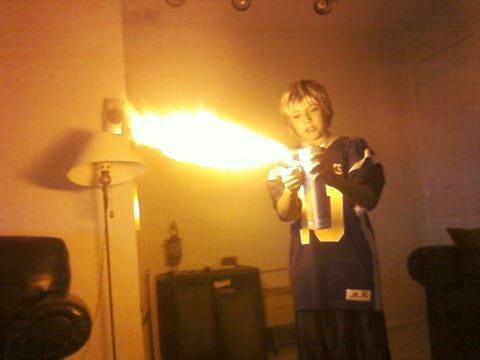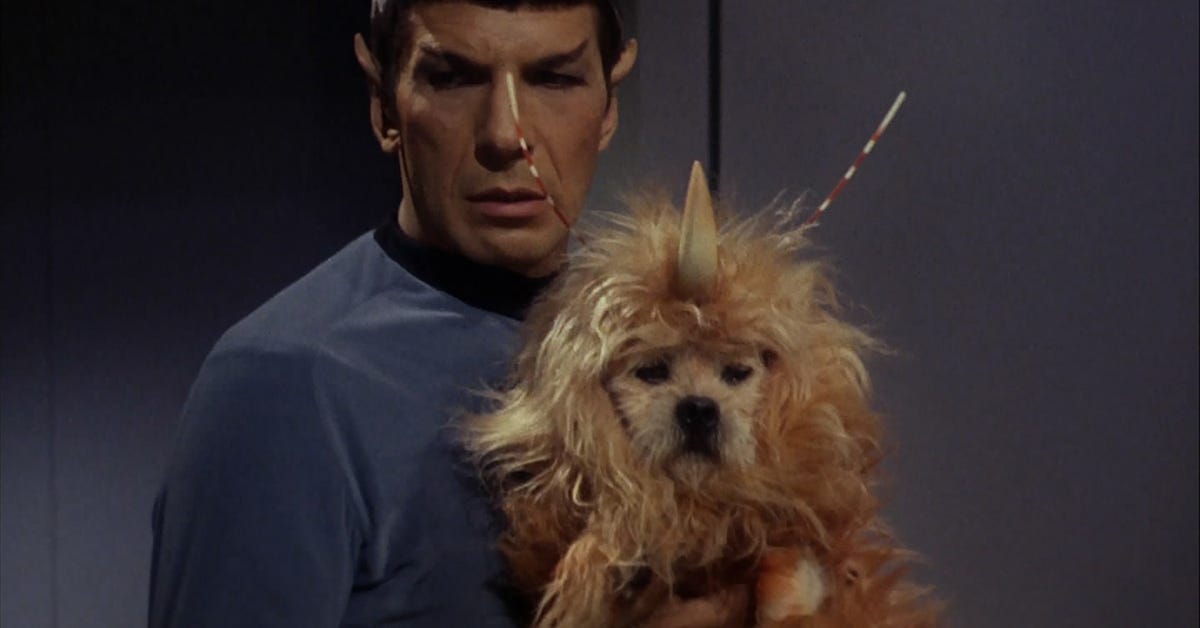Firestarter
In which we learn that experience is a function of luck; also, Kirk and the boys become Kirks and the boys.
When you stop and think about it for a moment, the lighter—that thing you use to light up a cigarette or set fire to a village in Vietnam—is a miracle of ingenuity. For most of human history starting a fire meant long labor to create and carefully nurse an ember into flame. The process was subject to the vagaries of weather and required technique and the availability of a variety of materials—iron, flint, tinder. The lighter takes the whole process and all of the crap that people used to carry around in tinderboxes and packages it in a self-contained mechanism you can toss around with reckless abandon. The thumb turns a knurled steel wheel, striking sparks against a ferrocerium rod (thank you Carl Auer von Welsbach), which ignite a stream of butane released from an internal fuel pod by the residual action of the thumb coming to rest upon a small lever attached to a valve. Instant reliable flame, so easy a child can do it.
Naturally children did do it, and next thing you know lighters are kitted out with all sorts of child-resistant mechanisms, which sorta undermines the point of them. But I get it. I was a firebug as a child. My friends and I played with fire often and enthusiastically. At nine years of age I spent the Fourth of July roaming our neighborhood in Huntsville, Alabama with my besties and a brown paper grocery bag full of fireworks, which we would shoot at other kids and their bags of fireworks wherever we found them. I survived without loss of limb or life, which I guess makes me a winner. Or a lucky duck anyway.
From the Dayton Daily News, April, 1979: “Another technique [Dayton Ohio Fire Lt. David] Chance has not yet tried but which he says has been effective elsewhere is the ‘match test.’ The child is taken to a safe place and forced to properly light and extinguish 200 matches. The idea, Chance says, is that the child’s repetition of the exercise ‘will bore him to death with matches’ and stifle his fascination with fire.” Contemporaneous with this ludicrous suggestion, culled no doubt from old movies in which teenage delinquents are forced by their parents to smoke an entire case of cigarettes, I was engaged in behavior that would have caused the author to—quite literally—shit her pants. Contrary to her assertion that “child firesetters are bullies, loners or neglected children simply trying to attract attention,” I spent pretty much all of my time with my friends Winter and Donovan and Randy building a clubhouse behind Winter’s apartment. We constructed it out of scavenged plywood nailed to a small cluster of pine trees that formed our frame. For the roof we cut pine branches and piled them atop a crisscrossing mesh of two-by-fours and broomsticks and other errata gathered during periodic dumpster dives. Pine needles, by the way, are fantastically flammable.
Inside this death box we made torches out of sticks with the ends wrapped in toilet paper. We lit the torches and held them aloft like tiny Neanderthals, nonchalantly smothering flames as they leapt into the roofing. We did this until our faces were black with soot and only gave it up I reckon because we were disappointed that the roof was so much more flammable than the torches, which tended to roar for fifteen or twenty seconds before they turned into showers of ash and embers.
We weren’t content only to set ourselves or other children aflame, mind you. One of our favorite pastimes then was making fire balloons. We would walk over to the Dirt Hills, which is what we called the empty field next to our apartment complex—a large vacant lot with little hillocks and ditches suitable for playing war, jumping bicycles, stepping on broken glass and rusty nails. The patchy vegetation was mostly tall, dry grass. We would lay sheets of newspaper in the dirt, lift up two corners on one diagonal, and twist them together, then do the same with the other two corners, resulting in a squarish balloon. This we would light on fire.
Before the structural integrity of the whole was fully compromised, the balloons would float up into the air, usually to drift over the dry grasses of the Dirt Hills or occasionally over University Drive, where they would rain embers down onto passing automobiles.
We never once burned ourselves to death. We never once burned down a building or set a car on fire. We never were caught, never reprimanded. This is all probably a searing condemnation of everything about the way the world worked in 1979, but on the plus side I learned a lot about fire, much of it very useful.
In his book Into the Wild Jon Krakauer relates a story of John Muir as a young man spending a night in a redwood tree during a powerful storm, and concludes that the difference between Muir—a now-famous early American naturalist who has an actual forest named after him—and the book’s subject Chris McCandless—who starved to death in the Alaskan wilderness—was merely chance. Muir survived his reckless behavior and benefited from the wisdom he acquired by it, while McCandless did not and is reckoned a fool. He was green, we say. But we were all green at one time, and if we aren’t now it’s only because we were lucky enough to live through it.
Star Trek, S01E05: The Enemy Within
I never intended for this to become a regular roast of William Shatner, honestly. Spock was my favorite character when I was a boy, but Kirk had some Elvis in him. It was this intrinsic charisma and his sharply angled sideburns that saved him from his bewildering acting style, which lay somewhere between community theater and town crier, and nowhere were his bellowing and facial contortions more evident than in this, the fifth episode of Star Trek, “The Enemy Within.” Side note: this is the fifth episode of the show and the fifth episode to feature Kirk either wholly or partially shirtless. I have no idea what these people were thinking.
“Enemy” is set in motion when a transporter malfunction produces two contrasting Kirks—a good one and a bad one. The good one is pretty much just ordinary Kirk, except that he’s somewhat indecisive. To me it seems like he just smoked a giant spliff, but we are given to understand that he’s been split in two and this half lacks the animal instinct and strong will to act resolutely. Ok.
The bad half is what happens when you’re sitting around alone at home and you think, “I could be an actor,” and you try pretending to be angry just to see how easy it is. He spits and snarls and bellows, always lit from below like you do when you’re on a camping trip telling terrible ghost stories. It’s all comical at best. There is one disturbing scene in which he sexually assaults the eternal victim Janice Rand, but the half-baked blocking—at one moment she tries to stop him by throwing an easel at him; she probably would have had better luck lecturing him on her murky painting style—that at least might have bored him to sleep. This and the cringey revelation of the assault to Spock and Bones a couple scenes later rather undercut the seriousness of the moment.
The story is kept singing along by a subplot involving Sulu and a bunch of fodder stuck on the surface of the planet they are orbiting, as the temperatures drop well below freezing, threatening to result in a Sulu popsicle. “Enemy” was written by Richard Matheson, who is best known for his novel I Am Legend. Matheson has said that he wasn’t happy with the subplot, which was not in his original script, and I’m somewhat inclined to agree. There are potentially some juicy philosophical questions to be had in the main story, but these wind up getting trampled under the pressure of Sulu’s quandary.
As a result, we’re left wondering why decisiveness is “bad” and how the transporter knew enough about ethics to divvy Kirk’s character up so neatly. We are told—and there’s no basis for this conclusion other than pop psychology—that Kirk cannot live without both of his halves and that, given the situation on the planet, they have no choice but to run the pair of them through the transporter again and hope for the best, even though they’d already tried this on a dog in a unicorn costume that had been similarly split and were now the proud owners of a dead unicorndog. I get what they were aiming at—the idea that one must reconcile contradicting forces in order to arrive at a functional whole at least opens the door to ontological dualism, a subject dear to the heart of every thinking Southerner. But it’s given short shrift; merely a platitude and we’re moving on to other things. It’s a pity.
Again, though, in “Enemy” we continue to catch glimpses of what Star Trek can be at its best. This is one of a few episodes to be scored in its entirety, by the superb film composer Sol Kaplan. Kaplan also scored “The Doomsday Machine,” which is a personal favorite. The music written for these two episodes was used extensively in others, presumably because it was damn good and it’s not like the production was rolling in dollars. Kaplan’s music is structured around the leitmotif method, pioneered by Richard Wagner a hundred years prior, in which musical themes are attached to major characters—in this case these are primarily written for the good and bad Kirks. Leitmotifs are typically sliced and diced with Alexander Courage’s main theme music and often with each other as the dramatic situation dictates. It’s a sophisticated technique, and would become a staple of film music when John Williams used it to such effect in Star Wars in 1977. This was eleven years earlier, on a show that cost less per episode than approximately 10 minutes’ worth of the Vietnam War. And Kaplan didn’t just write the music; he performed and conducted NBC’s house orchestra in the recording, which is as good today as it was then. It’s an amazing achievement, and one I can’t help but think of whenever I watch a modern film or television show with a forgettable score consisting of vague, aimless synthesizer chords.
It’s a funny thing: Star Trek often scoured the bottom of the barrel for acting talent, getting mostly very arch performances from what must have been stage actors without much feel for the small screen. It feels not unlike Rawhide or Bonanza at times in this regard. Yet the idea of craft in film and television was still singularly important—which is why B movies from 1966 are often so much more memorable than B movies from 2016. It’s been more than a decade since I’ve seen even my favorite episodes, so it’s anybody’s guess as to whether anything in this show really holds up to the test of time, but I keep getting brief hints of greatness and I can’t help but root for Roddenberry and crew to really turn out something sublime.




